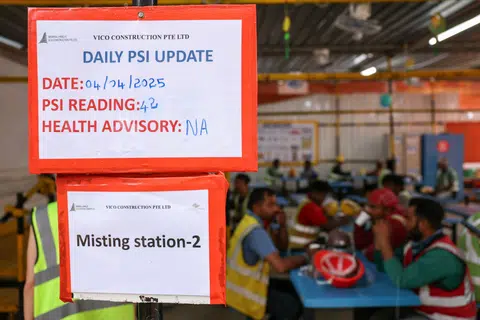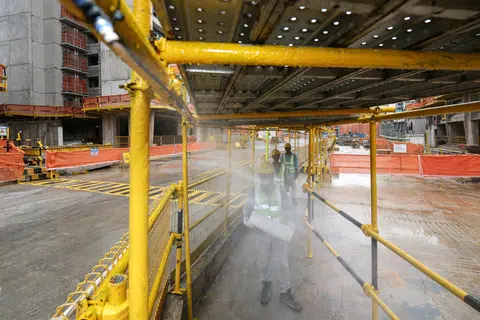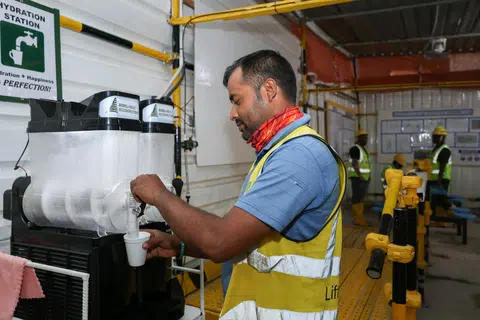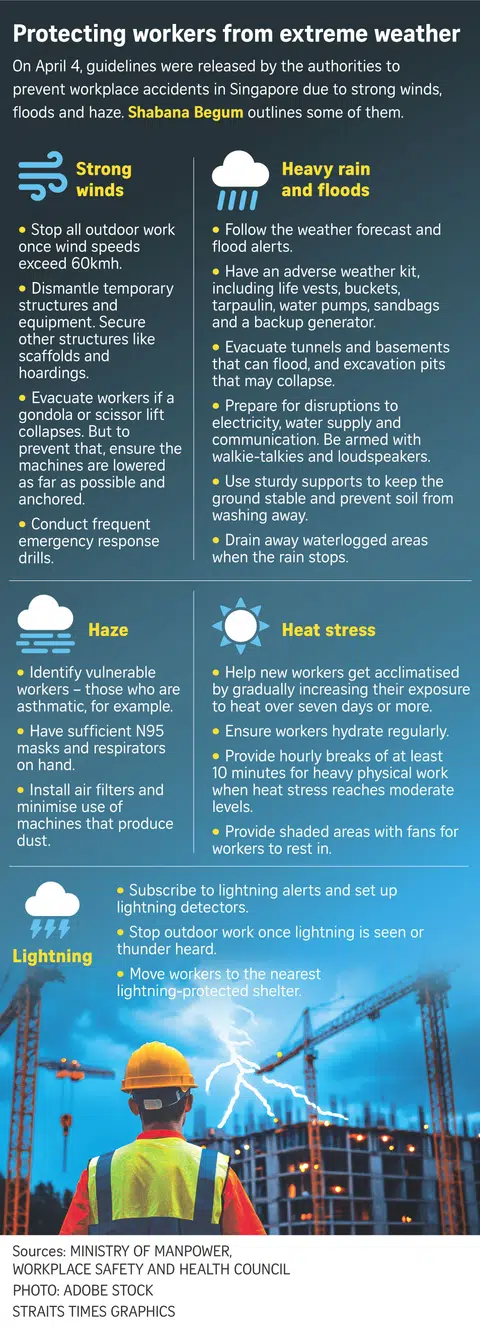MOM strengthens worker protection against extreme weather events
Workers here will be better protected from a wider range of adverse weather events, such as floods, strong winds and haze, under a new set of guidelines released by the authorities on April 4.
These guidelines - released by the Ministry of Manpower (MOM) and the Workplace Safety and Health Council - add to existing measures on protecting outdoor workers from heat stress.
For example, if wind gusts are expected, worksites must now take steps to secure loose equipment and temporary structures. During a deluge, workers in tunnels, basements and excavation pits should be evacuated as those underground sites can collapse.
Climate change is also expected to cause more extreme weather events, from soaring temperatures to intense rain that can cause flash floods. Over the years, weather events have claimed lives and caused injuries at worksites across the country.
In the past five years, there were three workplace deaths linked to strong winds and lightning strikes, said Senior Minister of State for Manpower Zaqy Mohamad during a visit to a Housing Board Build-To-Order construction site in Ang Mo Kio.
In 2022, a worker died from head injuries when a 20-foot container office he was working in was blown off its steel support by strong wind during a heavy downpour. In July 2024, a worker deployed for antenna installation work at the open rooftop of a building collapsed when he was struck by lightning. He later died in hospital. Singapore has one of the highest rates of lightning strikes in the world.
A man was working on the rooftop of a seven-storey condominium on a hot day in 2022 before he fell to his death. A coroner later ruled that the 37-year-old was likely disoriented due to heat stress.
"These are some risks, sometimes hard to prevent, but I think we have to be mindful of the conditions we make our workers work under, whether it is lightning risk, wind, or even rain, slippages, floods... people might drown. So let us prepare our worksites better," said Mr Zaqy at the Central Weave @ AMK construction site.

Vico Construction - the contractor at the Ang Mo Kio site - has also put in additional measures to help workers beat the heat. These include a water misting system across a walkway, and ice slushie machines.

The collapse and breakdown of structures and equipment were among the top three causes of workplace deaths in 2024, said MOM in its recently released workplace safety and health report.
Six out of 43 deaths that year were caused by structure collapse, although it is uncertain if weather events contributed to the accidents.
The 24-page report, published on the council's website, outlines what worksites should do to gear up for erratic weather, measures to take to prevent accidents and resume work safely after lashing rain or flooding. Employers should track the weather forecast and install equipment to measure heat stress levels and detect lightning. When adverse weather looms, MOM will inform workplaces before its onset as early as possible.
The guidelines also fleshed out wind speed thresholds that will cause damage. All outdoor work should cease once wind speeds exceed 60kmh. Singapore's average wind speed is 7kmh.
Beyond 60kmh, winds can break twigs and blow over barricades. At 80kmh, buildings can get slightly damaged. In 2023, a rare, tornado-like landspout sent large pieces of debris flying around a Changi East construction site, which includes the site for Changi Airport Terminal 5. Nobody was injured.
A landspout is the rarer cousin of a waterspout, and it can arise from an intense thunderstorm under unstable atmospheric conditions.
Such rare events and sudden thunderstorms can be difficult to predict far in advance. On Sept 17, 2024, a blustery Sumatra squall swept across the whole of Singapore within 1½ hours, bringing widespread thundery showers and gusty winds that damaged more than 300 trees islandwide.
A glass canopy outside UOB Plaza was damaged then, and metal debris and glass shards were strewn on the road outside the complex.
Workplaces should also conduct regular drills so that employees are familiar with what they need to do when disaster hits - from anchoring loose structures to evacuating in time.
The guidelines were designed broadly to cover various sectors, including construction, marine and chemicals, and even underground worksites, said MOM.

Industries can thus tailor the recommendations to their situation, based on the risks at their workplaces and realities on the ground.
While adhering to the guidelines is not mandatory, there are obligations under the Workplace Safety and Health Act to maintain safe workplaces, MOM added.
The ministry will conduct checks of worksites to ensure the right safety measures are in place to prevent incidents. Employers should have taken all reasonable measures to prevent accidents as per the Act. And if safety lapses are found, enforcement action will be taken, it added.
During the hotter months of 2024, around a third of 250 workplaces inspected were found to have breached heat safety rules. Employees were not given adequate rest breaks under shade or were not put through heat acclimatisation programmes, among other contraventions.
Taking enforcement action, MOM imposed fines and issued notices of non-compliance to the 78 sites, which included construction sites, shipyards, process plants and landscaping sites.

Shabana Begum for The Straits Times